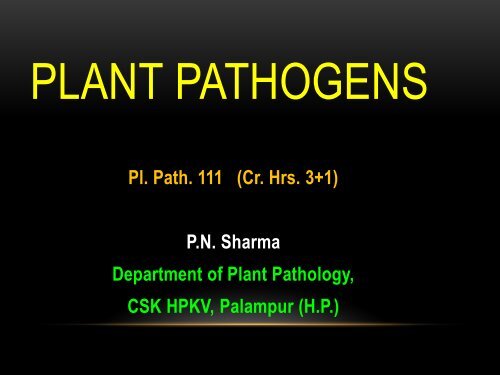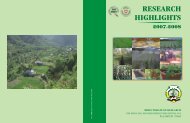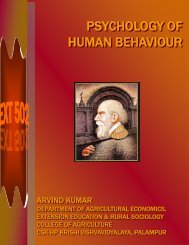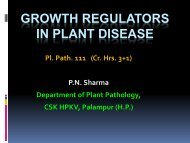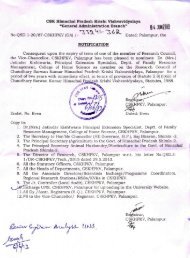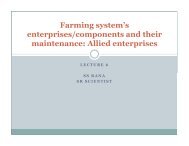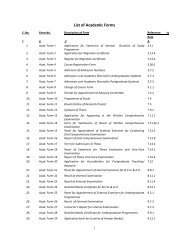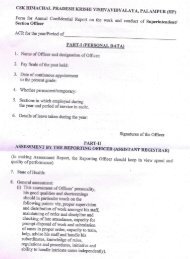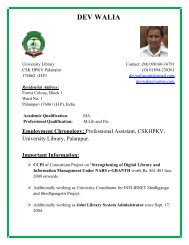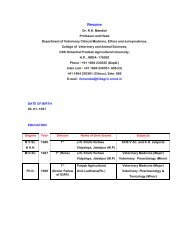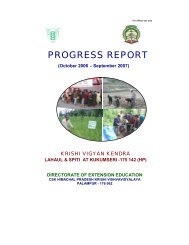Pl. Path. 111 (Cr. Hrs. 3+1) P.N. Sharma Department of Plant ...
Pl. Path. 111 (Cr. Hrs. 3+1) P.N. Sharma Department of Plant ...
Pl. Path. 111 (Cr. Hrs. 3+1) P.N. Sharma Department of Plant ...
You also want an ePaper? Increase the reach of your titles
YUMPU automatically turns print PDFs into web optimized ePapers that Google loves.
PLANT PATHOGENS<br />
<strong>Pl</strong>. <strong>Path</strong>. <strong>111</strong> (<strong>Cr</strong>. <strong>Hrs</strong>. <strong>3+1</strong>)<br />
P.N. <strong>Sharma</strong><br />
<strong>Department</strong> <strong>of</strong> <strong>Pl</strong>ant <strong>Path</strong>ology,<br />
CSK HPKV, Palampur (H.P.)
WHAT IS PATHOGEN?<br />
<strong>Path</strong>ogen:<br />
Any entity that can cause disease in a host<br />
eg. Fungus, Bacteria, virus, Phytoplasma,<br />
Viroids, RLO’s, Parasitic <strong>Pl</strong>ants, Nematodes<br />
Parasite<br />
An organism that lives on or in another<br />
organism and obtains food from the<br />
second organism
Fungus<br />
Fungus is nucleated spore bearing, achlorophyllous<br />
organisms which generally reproduce sexually or<br />
asexually and whose usually filamentous branched<br />
somatic structures are typically surrounded by cell wall<br />
containing cellulose or chitin or both.<br />
e.g. Phytophthora infestans<br />
Anton deBary<br />
Phytophthora infestans<br />
Teliospores <strong>of</strong> smut fungus
BACTERIA<br />
• Microscopic prokaryotic one-celled organisms that<br />
reproduce by binary fission.<br />
Wildfire bacterium <strong>of</strong> tobacco<br />
(Pseudomonas tabaci)
VIRUSES<br />
Matthews (1982; 2005) A virus can be defined as a set <strong>of</strong> one or more nucleic acid<br />
molecules ( either RNA or DNA) encased with in a coat or coats <strong>of</strong> protein or lipoproteins,<br />
replicate within a suitable host cell and with in such cells the virus<br />
production is dependent on:<br />
• host protein synthesizing machinery<br />
•Composed from a pool <strong>of</strong> components rather by binary fission<br />
•And are located at sites with in host cells that are not separated from host<br />
cell components.<br />
–Continually giving rise to variants through various changes in the viral<br />
nucleic acid.<br />
Tobacco mosaic virus
Viroids<br />
Viroids are small, low mol wt. RNA units<br />
(250-370 bp.), lack protein coat,<br />
replicate themselves and cause disease<br />
(TO Diener, 1971).<br />
e.g. Potato spindle tuber viroid (PSTVd),<br />
coconut cadang-cadang viroid (CCVd).<br />
T. O. Diener. Potatoes infected with potato spindle tuber viroid (PSTVd)
MYCOPLASMA (PHYTOPLSMA): (DOI ET AL., 1970)<br />
• are submicroscopic, measuring 150-300 nm in diameter having<br />
ribosomes and DNA strands enclosed by a bilayer membrane but<br />
not the cell wall, replicate by binary fission, can be cultured<br />
artificially in vitro on specific medium and are sensitive to certain<br />
antibiotics (tetracycline not to penicillin).<br />
E.g. Little leaf <strong>of</strong> brinjal, Peach yellow Spiroplasm citri (Fudt<br />
Allh et al. 1571) Citrus stubborn.
• Virusoids: (Keese & Simon 1986)<br />
A circular, single stranded voroid like satellite<br />
RNA measuring 300-400 base long,<br />
ecapsidated with single stranded linear RNA<br />
( 450 bp) <strong>of</strong> velvet tobacco mottle virus.
RICKETTSIAE: (WINDSOR AND BLACK, 1972)<br />
FASTIDIOUS VASCULAR BACTERIA<br />
• are non-motile bacteria measuring about 200 -300 nm in<br />
diameter, have cell wall, plasma membrane and cytoplasm<br />
containing ribosomes and DNA strands and are obligate:<br />
• 1. Multiply by binary fission<br />
• 2. Contain enzyme for ATP production<br />
e.g. Club leaf <strong>of</strong> clover, citrus greening<br />
Papaya bunchy top disease<br />
Citrus greening<br />
Candidatus liberobacter asiaticum
Nematodes<br />
Nematode are small, multicellular wormlike creatures. Many live<br />
freely in the soil, some species parasitize plants.<br />
E.g. Ear cockle <strong>of</strong> wheat caused by Anguina tritici & Potato<br />
cyst nematodes (Globerodera pallida)<br />
Wheat seed-gall Nematode Anguina tritici<br />
A. Typical plant parasitic nematode. (B) head <strong>of</strong> a plant parasitic nematode with stylet..
ALGAE<br />
• Green algae are single-celled or multicellular organisms that form<br />
colonies, free-living organisms, all <strong>of</strong> which have chlorophyll b.<br />
• Some <strong>of</strong> the green algae are parasitic on higher plants.<br />
e.g. Cephaleuros green algae, attack tea, c<strong>of</strong>fee, cacao, black<br />
pepper<br />
Colonies <strong>of</strong> the parasitic green alga<br />
Cephaleuros virescens
PROTOZOA<br />
• The protozoa are mostly one-celled, microscopic organisms,<br />
generally motile, and have typical nuclei.<br />
• Protozoa move by flagella, by pseudopodia, or by movements<br />
<strong>of</strong> the cell itself.<br />
Phytomonas protozoa in a phloem sieve tube <strong>of</strong> root <strong>of</strong> oil palm tree affected with<br />
sudden wilt disease
HIGHER PARASITIC PLANTS<br />
• More than 2500 species <strong>of</strong> higher plants are known<br />
to live parasitically on other plants.<br />
• these parasites are vascular plants that have developed<br />
specialized organs which penetrate the tissues <strong>of</strong> other<br />
(host) vascular plants, establish connections to the host<br />
plant vascular elements, and absorb nutrients from them.<br />
Mistletoes<br />
Witchweed (Striga sp.)<br />
Common dodder (Cuscuta sp.)
Infectious diseases
Infectious disease agents are<br />
called pathogens.<br />
<strong>Path</strong>ogens can be classified as :<br />
‣ Obligate parasites<br />
‣ Biotrophs,<br />
‣ Facultative Parasites<br />
‣ Facultative Saprophytes<br />
‣ Necrotrophs
PRIONS: PRUSINER (1982)<br />
• Prion is an infectious agent composed <strong>of</strong> protein in a<br />
misfolded form.<br />
• This is in contrast to all other known infectious agents, which must<br />
contain nucleic acid (either DNA, RNA, or both) along with protein<br />
components.<br />
Prions causes encephaloatthies in mammals, including "mad cow disease"<br />
Stanley Prusiner.<br />
Schematic presentation <strong>of</strong> a normal protein and <strong>of</strong> a deformed inactive one, i.e., a prion.
• Chlamydiae: are obligate parasites and lack an energy generating system<br />
Have two phases in their life cycle.<br />
• Outside the host cell they exist as infectious elementary bodies measuring about 300 nm in<br />
diameter, have dense contents, no cell wall and are specialized for extracellular survival.<br />
• Elementary bodies enter the host cell by phagocytosis and with in 8 hours, it is converted into much<br />
longer non-infectious reticulate body bounded by bilayer membrane derived from host cell. The<br />
reticulate body divide by binary fission with in this membrane and give rise to thousands <strong>of</strong> progeny<br />
with in 40-60 hours. These reticulate bodies are converted into elementary bodies and are released<br />
when the host cell lyses.<br />
• E.g.These cause psittacosis.<br />
Chlamydophila psittaci (formerly<br />
Chlamydia psittaci)
PROOF OF PATHOGENECITY<br />
KOCH’S POSTULATES<br />
1<br />
Association <strong>of</strong><br />
pathogen with<br />
diseased host<br />
4<br />
Re-isolation <strong>of</strong><br />
pathogen<br />
2<br />
Isolation <strong>of</strong><br />
pathogen<br />
3<br />
Inoculation <strong>of</strong><br />
pathogen on<br />
healthy host<br />
• <strong>Path</strong>ogen must ALWAYS be<br />
associated with disease in ALL<br />
diseased plants.<br />
• <strong>Path</strong>ogen must be isolated and<br />
established in PURE culture.<br />
• Inoculation <strong>of</strong> a healthy plant <strong>of</strong> the<br />
same variety must reproduce<br />
EXACTLY the same symptom(s).<br />
• <strong>Path</strong>ogen must be re-isolated from<br />
inoculated plant and its identity<br />
confirmed as the same as the original<br />
isolate.
DISORDER<br />
• Abnormalities in plants caused by abiotic or noninfectious<br />
agents are termed as disorders<br />
• Unfavourable environmental conditions<br />
• High or low temperature<br />
• Moisture stress or excess<br />
• Hail injury<br />
• Nutritional deficiencies<br />
• Nitrogen deficiency<br />
• Zn deficiency<br />
• Soil conditions<br />
• Air pollution
Noninfectious diseases
ACKNOWLEDGEMENTS<br />
• I gratefully acknowledge the use <strong>of</strong> some very<br />
important photographs given in text book “<strong>Pl</strong>ant<br />
<strong>Path</strong>ology” by G N Agrios.<br />
• I also acknowledge the scientists who spent valuable<br />
time in generating information on various aspects <strong>of</strong><br />
plant pathology and displayed the same on internet<br />
for use by students, teachers and researchers<br />
• Lecture dedicated to respected “G N Agrios”


